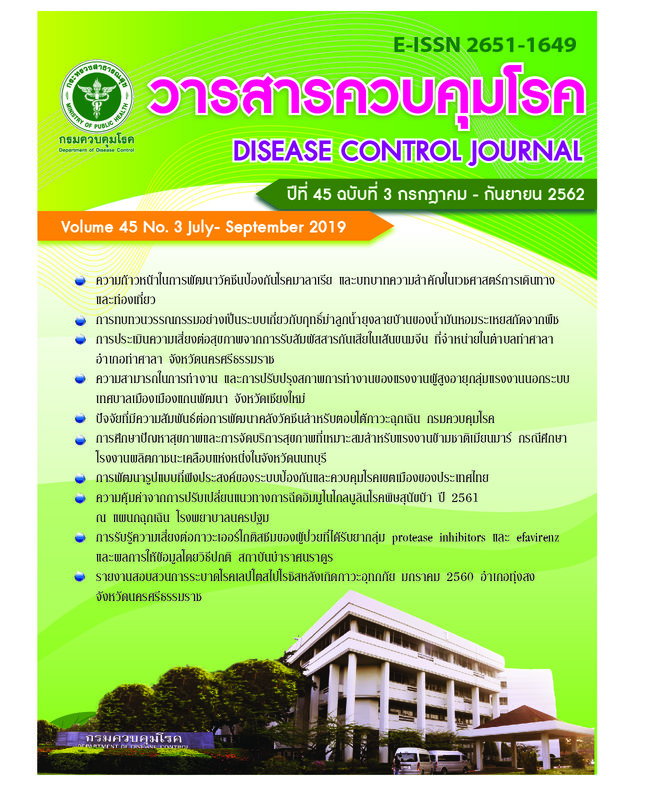The study of health problems and appropriate health services for Myanmar migrant workers: a case study of an enamelware factory in Nonthaburi Province
DOI:
https://doi.org/10.14456/dcj.2019.26Keywords:
health problems, occupational health and safety service provision, Myanmar migrant workersAbstract
The objective of this research was to study health problems at the workplace among Myanmar migrant workers and factors related to health problems and obstacles in providing occupational health and safety services to Myanmar migrant workers in an enamelware factory in Nonthaburi Province. The sample was divided into 3 groups: 120 Myanmar migrant workers, an employer representative and 3 safety officers. Data on Myanmar migrant workers' health problems were collected with a questionnaire using an interpreter as a communication assistant. The results of this research indicated that most of sample Myanmar migrant workers were male (55.00%), aged 20-30 years (67.50%), and graduated with lower secondary education (53.30%). Total income plus OT pay was in the range of 5,000 to 10,000 baht per month (79.20%) and had over 2 years of working experiences in an enamelware factory (69.20%). Throughout the period of work in the enamelware factory, the most commonly found work-related symptoms were neck, shoulder and upper back pain (28.30%), followed by lower back, waist, hip and thigh pain (9.20%) and rash on hands or arms (7.50%). By analyzing factors related to health problems at the workplace by controlling the influence of other factors using binary logistics regression, the results indicated that knowledge about work safety was related to neck, shoulder and upper back pain with a statistical significance level (p<0.05). Based on an in-depth interview with the employer representative, the results showed that the key obstacles in working with Myanmar migrant workers were communication and cost of translating documents about occupational health and safety. Limited budget resulted in incomprehensive and inconsistent provision and education about occupational health and safety, and the model of providing health services for Myanmar migrant workers. Representatives should be assigned to communicate information on occupational health and safety activities. Besides, based on entrepreneurs’ suggestions, public and private organizations or related agencies should participate in assisting the provision of occupational health and safety services for Myanmar migrant workers in industrial factories. Burmese language training courses and safety media in particular are relatively expensive, resulting in incomprehensive and inconsistent provision of related trainings.
References
2. Samniang C. Migrant workers: Invisible man in Thailand [Internet]. [cited 2015 Aug 10]. Available from: https://www.bangkokbiznews.com/blog/detail/503498 (in Thai)
3. Achavanitkul K. Assessment of government health policy and health problem management for illegal foreign workers [Internet]. [cited 2015 Jan 10]. Available from: https://www.archanwell.org/autopage/show_page.php? t=32&s_id=1&d_id=2 (in Thai)
4. Niratorn N. Labor migration in ASEAN: A case study of unskilled labor in Thailand. under the article on How do we live together in ASEAN: the community with diversity presented at the TU-ASEAN seminar project; 2012 Apr 30; Sriburapa Auditorium, Thammasat University, Tha Prachan Campus, Bangkok. Bangkok: 2012. p. 1-11. (in Thai)
5. Nonthaburi Provincial Labor Office. Executive summary on local economic and labor situations, Nonthaburi Province in Q3/ 2015, 2-3 [Internet]. [cited 2012 Apr 30]. Available from: https://nonthaburi.mol.go.th/sites/nonthaburi.mol.go.th/files/enuuehaa_3.2558.pdf (in Thai)
6. Office of Industrial Economics, Ministry of Industry. Publication on interesting industries: Introduction to cement and ceramic industries. Bangkok: Office of Industrial Economics, Ministry of Industry; 2011. (in Thai)
7. Yothin S. Health status of pottery workers at Ban Mon Khao Kaeo, Pichai Sub-district, Mueang Lampang District [dissertation]. Chiang Mai: Chiang Mai University; 2010. 69 p. (in Thai)
8. Nursing Room Department, Enamelware factory. Logbook of the workplace infirmary services of an enamel container factory In Nonthaburi Province. Nonthaburi: Enamelware Factory; 2015. (in Thai)
9. Department of Labour Protection and Welfare. Occupational health and safety promotion project in the workplaces hiring foreign workers [Internet]. [cited 2016 Apr 18]. Available from: https://www.labour.go.th/th/index.php?option=com_content&view=article &id=21696:2557-07-30-11-07-34&catid=1:2011-03-31-03-24-26&Itemid=88. (in Thai)
10. Suwan R, Nanasilp P, Kaewthummanukul T. Occupational health hazards and health status related to risk among workers in large ceramic factory. Nursing Journal 2016;43: 67-78. (in Thai)
11. Thiamkao S. Repetitive strain injury [Internet]. [cited 2017 Dec 11]. Available from: https://haamor.com/th/การบาดเจ็บซ้ำซากจากงานซ้ำ (in Thai)
12. Pansupol K. Predictive factors of access to health service effecting on the health-related quality of life of Myanmar migrant workers in the workplace, Bang Pa-In Ayutthaya Province [dissertation]. Samut Prakan: Huachiew Chalermprakiet University; 2015. 90 p. (in Thai)
13. Bureau of Occupational and Environmental Diseases, Department of Disease Control. Guidelines for providing occupational health services on ergonomics to local labors for primary health care staff under Occupational Health Group. Nonthaburi: Bureau of Occupational and Environmental Diseases, Department of Disease Control; 2017. (in Thai)
Downloads
Published
How to Cite
Issue
Section
License
Articles published in the Disease Control Journal are considered as academic work, research or analysis of the personal opinion of the authors, not the opinion of the Thailand Department of Disease Control or editorial team. The authors must be responsible for their articles.



.png)



